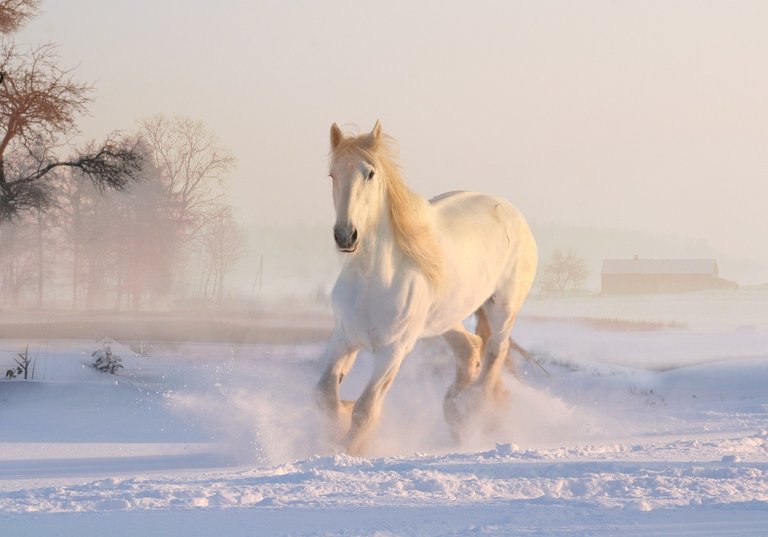Evolution of the modern horse
A discussion of the evolutionary history of several horses shows that several morphological changes have taken place with increasing size. The main major changes are in the shape and height of the horse's legs, teeth, and face. According to evolutionary history, Hyracotherium (Eohippus) is called the original horse. From this horse evolved the modern horse Equus through various mutations.
Changes that gave rise to the modern horse
What happened is as follows:
Physical size is increased.
Increased length of legs and feet.
Obtaining lateral finger reduction.
Better development of sensory organs.
Replacement of incisors by molars.
The spine is straight and strong.
The brain has become relatively large and complex in size.
The perfection of the razor.
The stages of horse evolution are as follows:
- Eohippus and Orohippus are the most common horses found in the Eocene period
Familiar American conditions.
Eohippus (Stage 1): was the first recorded fossil of equine evolution in the Lower Eocene strata of North America. Eohippus. This 12-inch-tall cat-like creature is believed to be the true ancestor of the horse. Evolutionists think Eohippus is a five-toed descendant, but it had 4 on its front feet and 3 on its hind feet. The ulna and fibula were completely separate and the teeth were progressing toward the crushing complex.
Extinct by the end of the Eocene.
Orohippus (2nd stage): Orohippus, derived from Eohippus. They appeared in the middle Eocene period. It inherited all the characteristics of the original horse. They had 4 toes on their front feet. The last molar teeth were of two molariform types.
Epihippus (Phase 3): These are equine fossils of the Upper Eocene stage. They were completely improved from the previous situation. This is because the third and fourth molars form full molars. They are larger than Oruhippus in size.
Oligocene: Two genera of horses were identified during the Oligocene period. Namely, Mesohippus Menhippus Meshipp lived in the Middle and Upper Guligocene and Mesonippus in the Lower Guligocene. Both types of horses are descended from the early Eocene horse. These horses made little progress compared to the previous ones.
Their legs and feet were long. All feet had three active toes. The first molar teeth are simple and the other three molars are arranged in a molariform pattern. The tips of the molar teeth had well-developed crests.
In size, the wolf was almost similar to the tiger. Horses of the genus Miohippus were larger than Mesohippus. All Guligocene horses evolved in North America and were able to migrate to Europe during the Miocene.
Miocene era. The base of the genera Merychippus and Hipparion survived into the Miocene. On the other hand, Hypolippea • Anchethesium both became extinct.
Parahippus (Stage 6): Parahippus appears in the Lower Miocene and is the true evolution of the horse. It represents an intermediate phase of the Miohippus Merychippus phase.
Features: 1. Their diastoma was well formed. Their lateral fingers were somewhat reduced.
Merychippus (Stage 7) The genus Merychippus arose directly from Parahippus in the late Miocene. At this stage, the sockets between the cusps began to fill with cement, and the lateral fingers were conspicuous in some species, as in Miohippus, but much fainter in others.
Protohippus: Derived from Merychuppus. Both baby teeth and permanent teeth had moderately long crowns
containing and cemented. The arms were three-fingered.
Evolutionary sidelines. Two evolutionary sidelines can be traced in the Miocene epoch. Namely the horse of the genus Hypoliprās Hipparion. Among them, Hipparion survived until the Piocene but ended in extinction at a later stage.
Pliocene: During this time, new land connections occurred but did not last long.
Pliohippus (Stage 8) was the first toe-toed horse probably derived from Pratahippua of the Miocene strata of Sapa. A peculiar hole in the front of the akshikotar and the fullness of the datta like a modern horse are its main features.
Plesippus (Stage 9): They appear in the Late Pliocene. There was only one finger on the arm. No lateral finger marks are seen. The style of the hoof was much superior to that of Pliohippus and the head was like that of the modern horse.
A rare equine fossil named Hippidion was discovered in South America in the Pliocene period, derived from the mother Prototipp. Hippidion was able to maintain its identity until the Gloistocene but was later transformed into Onohippidium.
Equus (Stage 10): These are the last stages of equine evolution. They first appear in Upper Pliocene strata in North America and Eurasia. Their arms were single-fingered, their arms long columnar and rich in enamel.
Pleistocene: Several extinct species of the genus Equus have been recovered from the Pleistocene strata of North and South America
is done But soon they were wiped out from the soil of both Americas. Living horses: Equus africanas are currently domesticated in the wild in Africa, Europe, and Asia respectively. Three horse species occur in E kiang, E. asianus. The latter is found all over the world in its domesticated state. The main evolutionary line of horses occurs in North America and later breeds in the Old World and South America.
I am a student of zoology and credit for this article goes to Madam Rita Parvin, Sir Shamol Shordar, Sir MD Rafikul Islam, Sir Shafiullah Shopon

Congratulations @jishan5! You have completed the following achievement on the Hive blockchain And have been rewarded with New badge(s)
Your next target is to reach 2000 replies.
You can view your badges on your board and compare yourself to others in the Ranking
If you no longer want to receive notifications, reply to this comment with the word
STOP